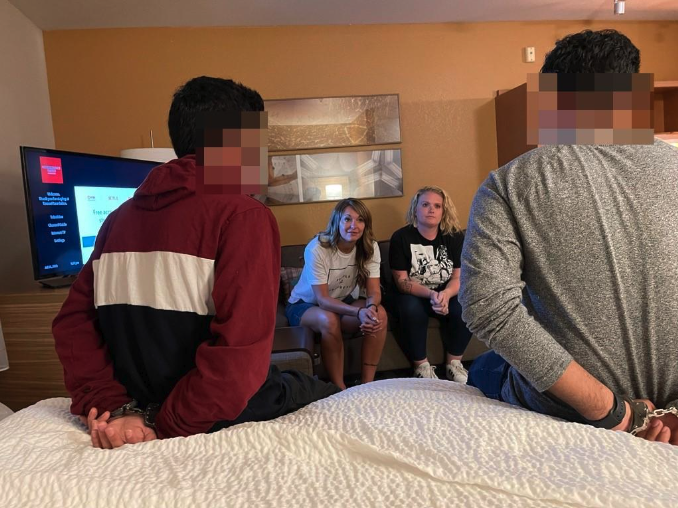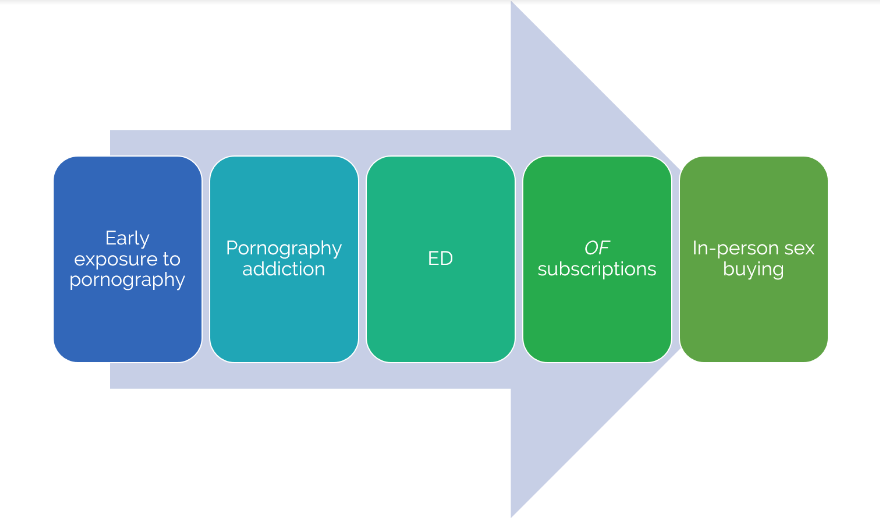The “Boy to Buyer” Pathway and How To Disrupt It
By Angie Henderson, Ph.D., University of Northern Colorado
I have had the privilege of gathering and analyzing data on the reasons men buy sex for the past six years.
This work has included:
- Analyzing the content on buyer boards, where men review their sex purchases
- Attending and evaluating what is commonly referred to as “john schools,” a class attended by men who are arrested for attempting to purchase sex
- Interviews with men immediately after an arrest for attempting to purchase sex
- Over 100 interviews with victims and survivors of sex trafficking, as well as those who at the time of interview identified as independent escorts
The stories I’ve heard have helped to paint a picture of what forces, both societal level and individual level (and everything in between), put boys on the path to becoming buyers.
It should be noted here that, in my six years of research on this topic, I have never encountered or heard from victims, survivors, or escorts that they’ve encountered a female sex buyer. This is supported by decades of research indicating that most sex buyers are men. Sex buying and exploitation are highly gendered. Thus, in order to truly stop the demand, it is pivotal to address the root causes of the problem instead of simply punishing the behavior and hoping for reformed men.
Society’s expectations for men
At the heart of this issue are the overarching cultural prescriptions that men and boys are often encouraged to express emotion in only one way: anger.
This socialization begins early, as boys are scolded for crying and expressing fear or vulnerability. Inversely, girls are often encouraged to express a much wider range of emotions (though, perhaps unironically, they are often discouraged from showing anger).
Coupled with our societal obsession with consumerism and instant gratification, young people are seeking ways to purchase goods and services to “help” them deal with their emotions, particularly those they do not feel safe expressing or discussing with their peers.
Women and girls are encouraged to lean toward self-help and self-defense, and men and boys toward outlets to take out anger.
And remember, as the great Jedi Master Yoda once said, “Fear is the path to the dark side … fear leads to anger … anger leads to hate … hate leads to suffering.”
Yoda’s words have played over and over in my head as I’ve listened to men describe why they decided to buy sex. Before I interview men after they are arrested for attempting to purchase sex, I try to channel my best Dr. Brene Brownand let them know I am not there to shame them.
My colleague sits right next to me, and we ask the men to look us in the eye so we can increase empathy, build trust, and hopefully improve understanding. We begin by asking how and why they ended up there today. Sometimes, their answers are brutally honest and vulnerable right away, and sometimes, it takes a little more rapport-building to get to the core of the issue.

Angie and her colleague talking to alleged sex buyers
Regardless of how soon we get there, we hear over and over one word: loneliness. Second to that, men admit they are afraid of being rejected, afraid of relationships, afraid of not being “man enough.”
Many willingly admit they have been experiencing erectile dysfunction and thought purchasing sex would provide a newer, more sensual experience that would correct that problem. They bring Viagra with them to their appointments to purchase sex.
Megan and I take this opportunity to let them know we have heard these same explanations from other men we’ve interviewed. The look of relief on their faces is something I will never get out of my head; after all, the antidote to shame is empathy.
Many begin to cry, and others sit silently. Megan is usually the one to ask how they can tell the difference between a sex trafficking victim and a “willing” participant that they purchase. Every single man admits there’s no way to know.
We challenge them to do the research, to use this opportunity as a turning point, and to read about what contributes to sex trafficking and what contributes to the exploitation of marginalized bodies.
The value of “doing the research”
As a researcher, I’d love to say I have longitudinal data from these men we’ve interviewed that shows that they’ve all stopped buying sex and are all now working to improve gender equality not only in their own communities but around the world.
Unfortunately, we don’t have that data (but it’s our dream to one day design a study to do just that!). But I can share an inspiring story that gives us both hope.
After the first opportunity to interview buyers after arrest, we had the conversation described above as part of a week-long training that ended in a buyer sting in rural Wyoming. In that jurisdiction, the men arrested spent the night in jail after the sting on Thursday.
One man followed Megan’s and my suggestion and went home that weekend and did the research. We know this because, on the following Monday, he returned to the sheriff’s office, which is adjacent to the jail where he spent the night just a few days prior, and asked to speak to the Sergeant who oversaw the sting. He did so because he wanted to let the Sergeant know that he “did what those ladies told me to do”; he did the research and felt awful for contributing to sex trafficking. He asked her to pass his gratitude to us for being kind, not shaming him, and for the education we provided him.
I don’t share this story to brag about that one guy. I share it because, based on our buyer interview data and our data analyzing the efficacy of “John schools,” I firmly believe that we can only stop demand if we commit to shifting culture.
Do men and boys need to be held accountable? Absolutely, yes.
Can we, as a society and as parents, do a better job upstream so boys do not become buyers? I firmly believe so (and I’m not alone; my friend Peter Qualliotine, founder of Modeling Equality, and my “big brother” Tom Perez of the EPIK Project, among others, agree).
The pathway from boy to buyer
Research has already established that early exposure to pornography is disturbing to children.Flood, M. (2009). The harms of pornography exposure among children and young people. Child Abuse Review: Journal of the British Association for the Study and Prevention of Child Abuse and Neglect, 18(6), 384-400.Copy
We also know that there’s an increased risk for those exposed to pornography at a young age to develop a pornography addiction or compulsion.
Based on the data we have collected from sex buyers, the vast majority of men arrested for sex have struggled with pornography addiction. We are also learning more about the pathway from “boy to buyer” as we continue to gather data.
In the summer of 2021, Megan and I noticed an alarming trend during one sex buyer sting. The men showing up to buy sex were markedly younger than those we had been used to seeing in these situations for over six years.
Because we had also been following the shifting landscape of the commercial sex trade after the widespread COVID-19 lockdowns, we knew about how popular OnlyFans was becoming. We adjusted our interview guide and asked the buyers if they’d heard of it.
The answer? A resounding 90% of the buyers we interviewed shared that they subscribed to content on OnlyFans, and one specifically told us, “It wasn’t doing it for me anymore, so I decided to do this in person.”
Others admitted to porn addiction, subscribing to OnlyFans, and experiencing erectile dysfunction as a result.
These men were in their early 20s. The pathway of how a boy becomes a buyer is becoming increasingly clear.

Buyer pathway diagram, provided by Angie
OnlyFans can serve the same purpose as a pornography addiction, but as buyers on review boards admit, it’s better because it’s personalized, made-to-order explicit content.
Buyers use it to “window shop” for individuals on the platform, taking the opportunity to search for content creators in their area to private message on the platform to meet up and solicit for in-person sex transactions.
Addressing sex-buying trends
All of these trends are alarming. With the sharp increase in popularity of the OnlyFans platform, a whole new demographic of (much younger) men is entering the commercial sex market.
In five years, demand for commercial sex could be at levels we’ve never seen in modern history. However, as we continue to learn more about the demand for commercial sex, there is more opportunity to address these alarming trends.
First, as other researchers and activists have stated, it is beyond time we start raising our men and boys differently. And I’m not just talking about consent. I’m talking about validating emotions and encouraging the expression of fear and vulnerability so it doesn’t manifest as anger.
Whenever someone asks me what they can do to prevent their daughters from being trafficked, I ask them to shift their perspective and instead focus on their sons or young men and boys in their lives.
In their interviews, survivors have told me repeatedly that men who show up to buy sex are looking for connection, belonging, and acceptance. (Not all of them! But enough for it to come up often in my research.)
Though these trends are alarming, there is hope. Given the research we have on pornography, the erectile dysfunction epidemic among young men, the rise of OnlyFans in popularity, and sex buying, we can actually begin to address these issues through prevention, intervention, and, ultimately, restoration.
Young people at the World Without Exploitation Youth Coalition as well as folks at EPIK Project, Connect Ed, and Modeling Equality, to name a few, are off to a great start.
About the Author
Dr. Angie Henderson is a Professor of Sociology at the University of Northern Colorado in Greeley, Colorado. With expertise in qualitative research design, she has published over 30 peer-reviewed journal articles, 4 book chapters, and two co-authored textbooks. Her research on how traffickers use substances to control their victims was published in Urban Crime: An International Journal in April 2022, and her research on bottoms—the second-in-command in a sex trafficking operation—was published The Journal of Human Trafficking in January 2022. Dr. Henderson has extensive expertise in studying the experiences of victims and survivors of sex trafficking, as well as sex buyers. In her spare time, she enjoys hiking, biking, boating, and watching soccer with her three children and her dog, Betty White.
Your Support Matters Now More Than Ever
Most kids today are exposed to porn by the age of 12. By the time they’re teenagers, 75% of boys and 70% of girls have already viewed itRobb, M.B., & Mann, S. (2023). Teens and pornography. San Francisco, CA: Common Sense.Copy —often before they’ve had a single healthy conversation about it.
Even more concerning: over half of boys and nearly 40% of girls believe porn is a realistic depiction of sexMartellozzo, E., Monaghan, A., Adler, J. R., Davidson, J., Leyva, R., & Horvath, M. A. H. (2016). “I wasn’t sure it was normal to watch it”: A quantitative and qualitative examination of the impact of online pornography on the values, attitudes, beliefs and behaviours of children and young people. Middlesex University, NSPCC, & Office of the Children’s Commissioner.Copy . And among teens who have seen porn, more than 79% of teens use it to learn how to have sexRobb, M.B., & Mann, S. (2023). Teens and pornography. San Francisco, CA: Common Sense.Copy . That means millions of young people are getting sex ed from violent, degrading content, which becomes their baseline understanding of intimacy. Out of the most popular porn, 33%-88% of videos contain physical aggression and nonconsensual violence-related themesFritz, N., Malic, V., Paul, B., & Zhou, Y. (2020). A descriptive analysis of the types, targets, and relative frequency of aggression in mainstream pornography. Archives of Sexual Behavior, 49(8), 3041-3053. doi:10.1007/s10508-020-01773-0Copy Bridges et al., 2010, “Aggression and Sexual Behavior in Best-Selling Pornography Videos: A Content Analysis,” Violence Against Women.Copy .
From increasing rates of loneliness, depression, and self-doubt, to distorted views of sex, reduced relationship satisfaction, and riskier sexual behavior among teens, porn is impacting individuals, relationships, and society worldwideFight the New Drug. (2024, May). Get the Facts (Series of web articles). Fight the New Drug.Copy .
This is why Fight the New Drug exists—but we can’t do it without you.
Your donation directly fuels the creation of new educational resources, including our awareness-raising videos, podcasts, research-driven articles, engaging school presentations, and digital tools that reach youth where they are: online and in school. It equips individuals, parents, educators, and youth with trustworthy resources to start the conversation.
Will you join us? We’re grateful for whatever you can give—but a recurring donation makes the biggest difference. Every dollar directly supports our vital work, and every individual we reach decreases sexual exploitation. Let’s fight for real love:





